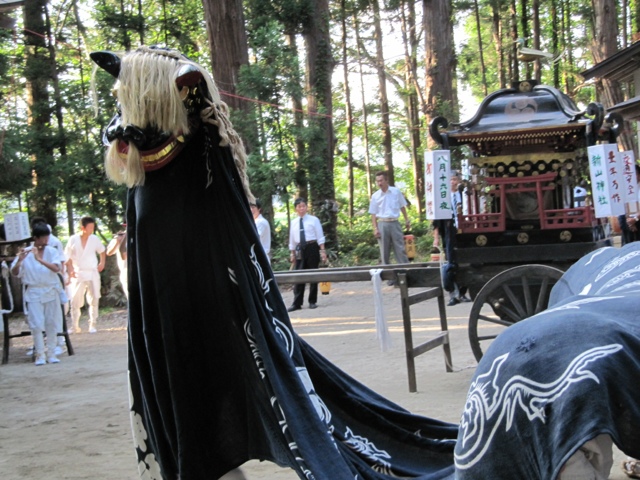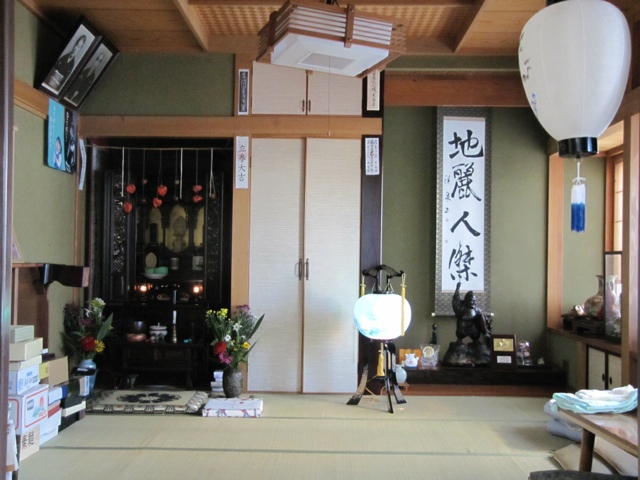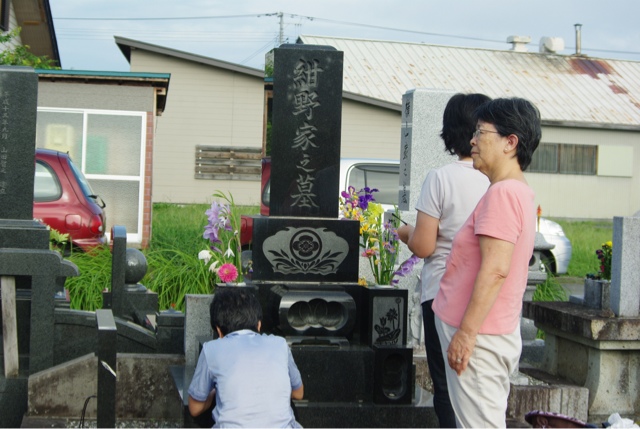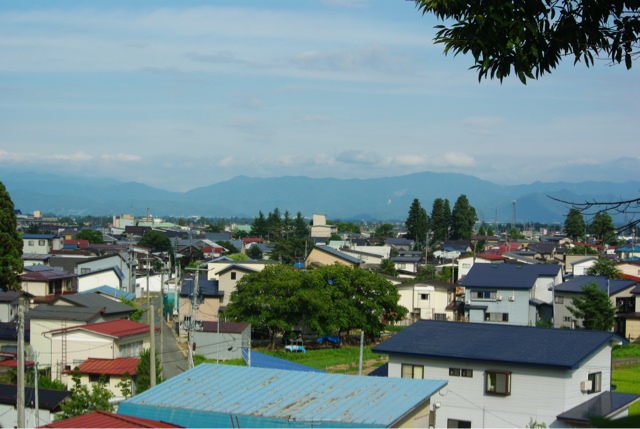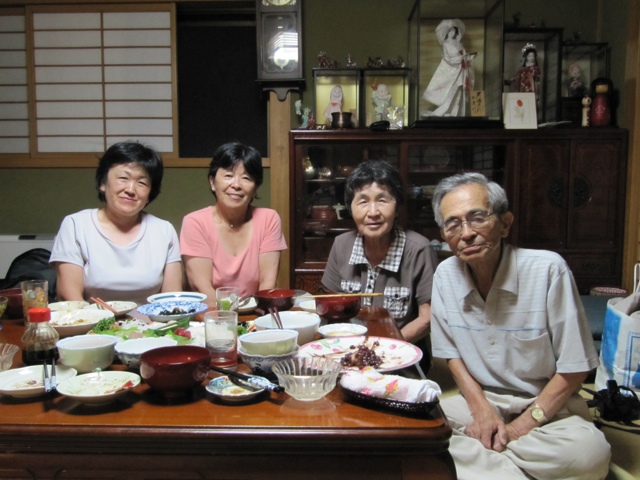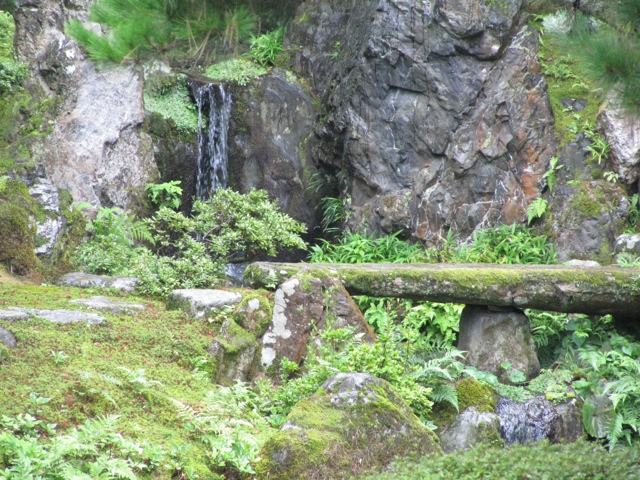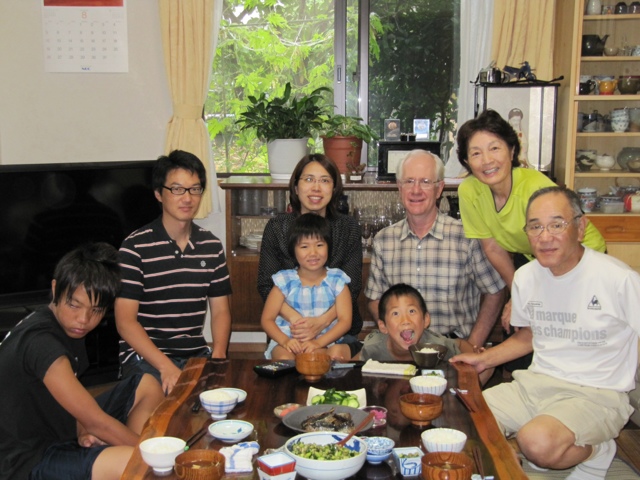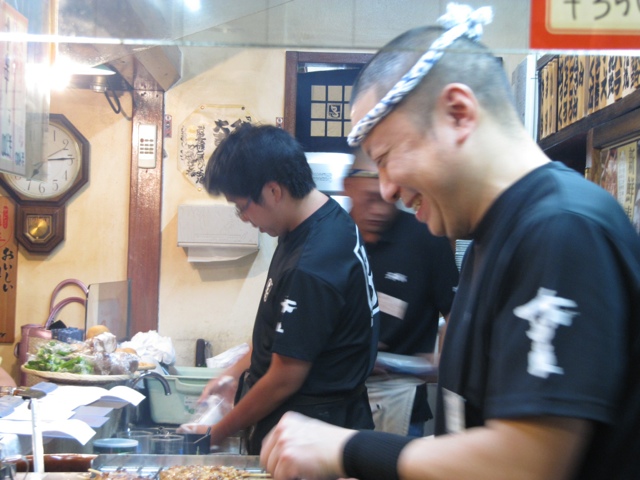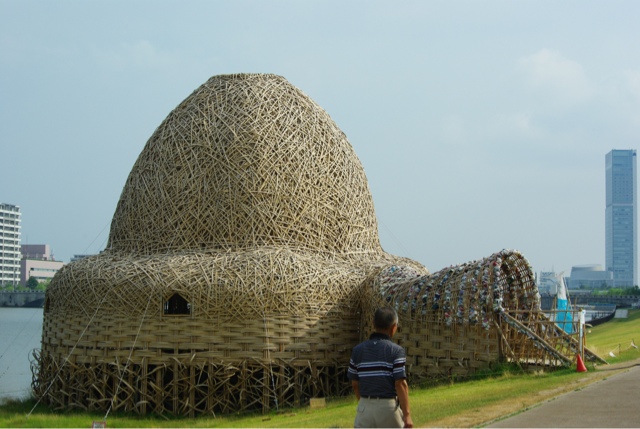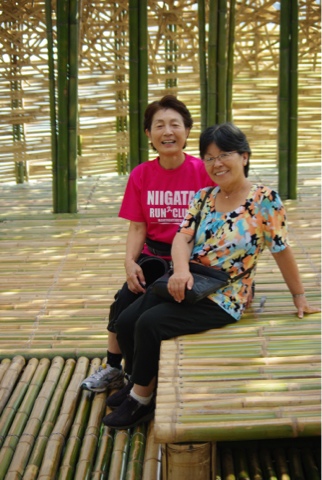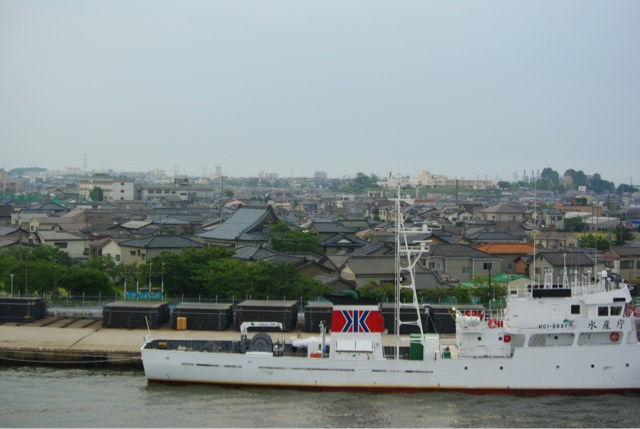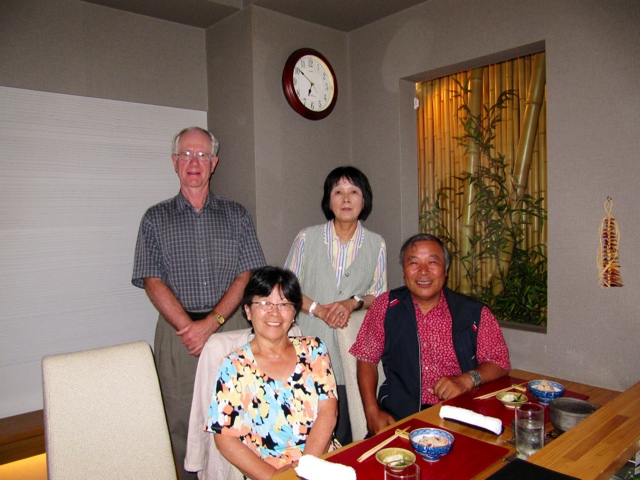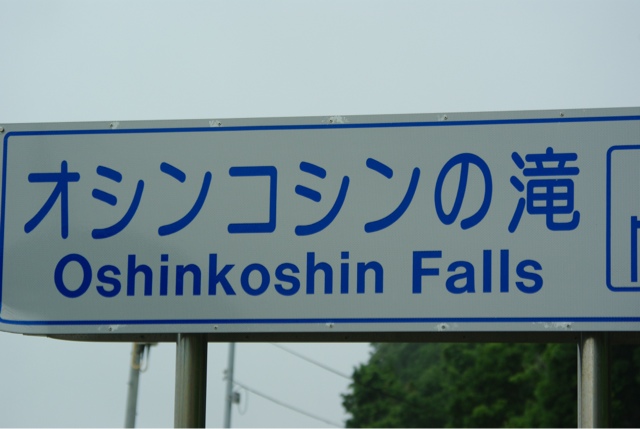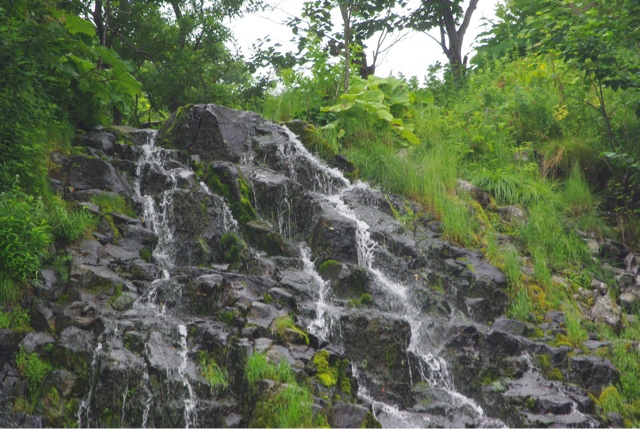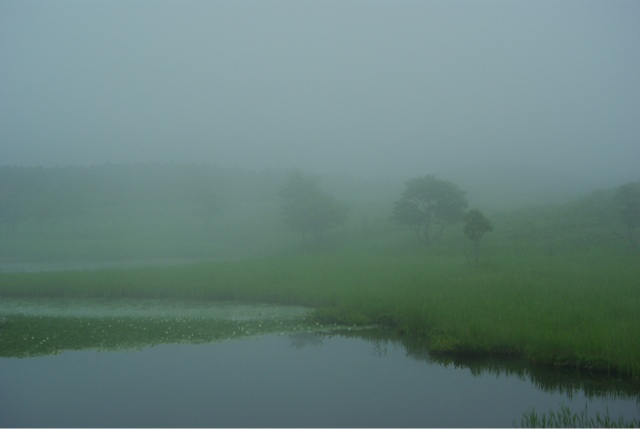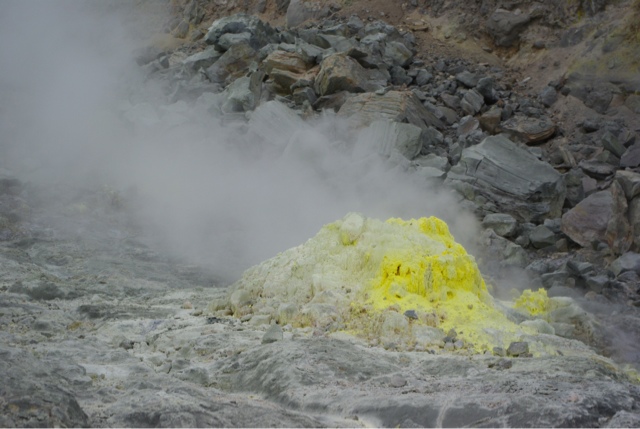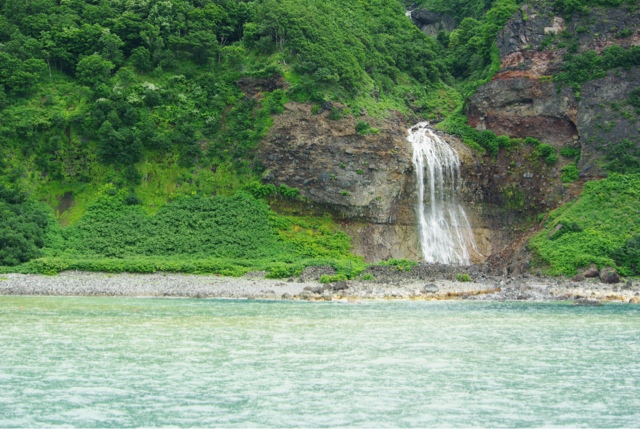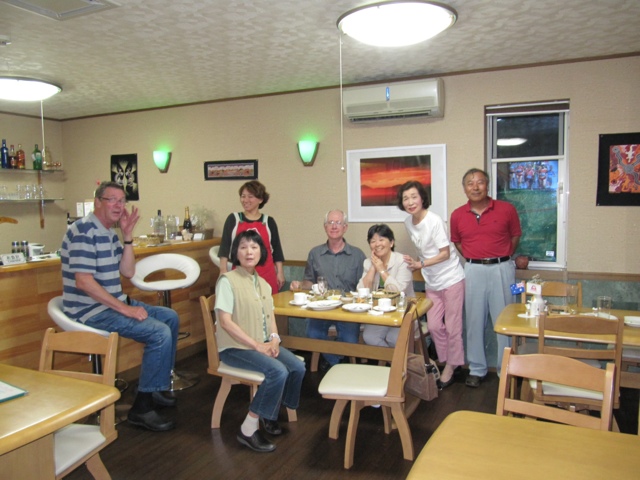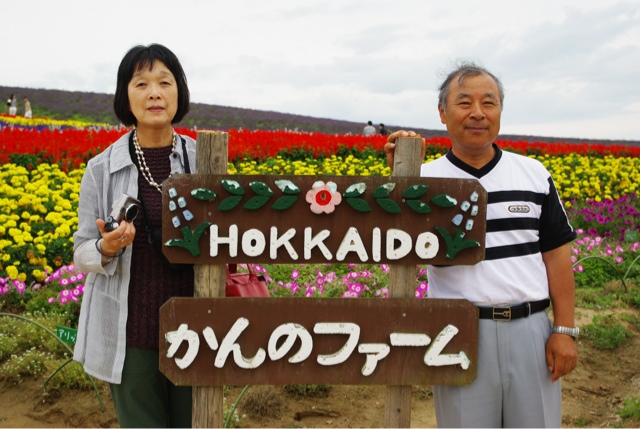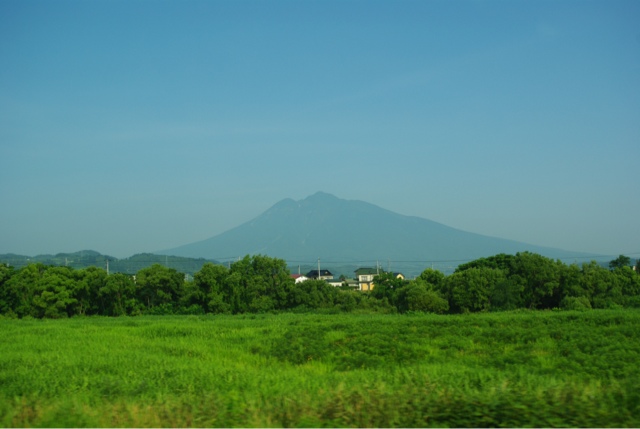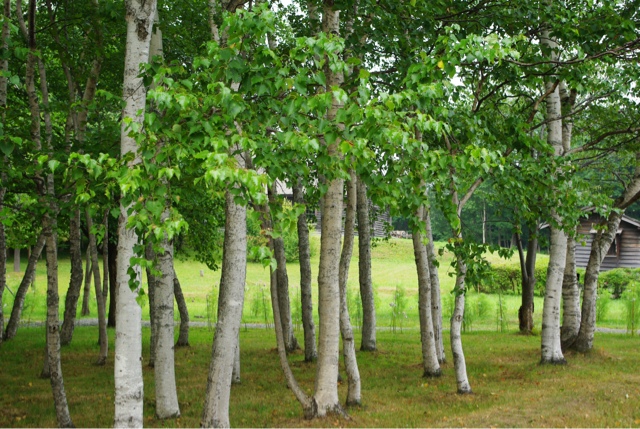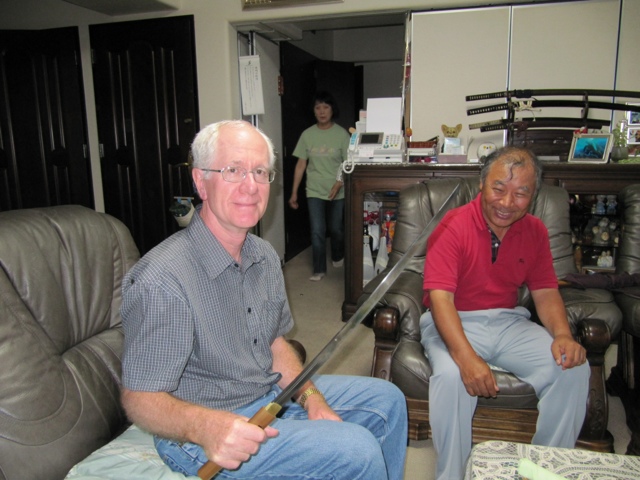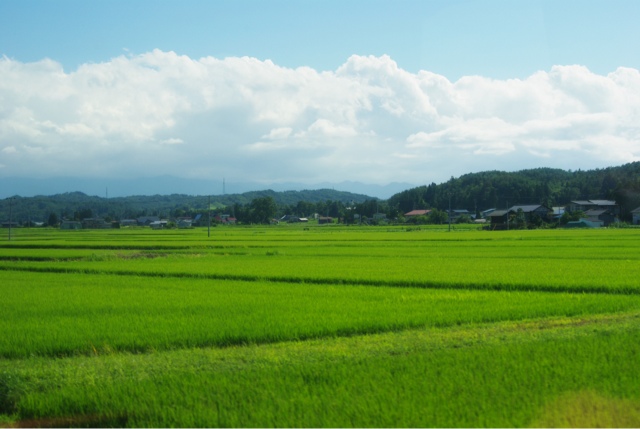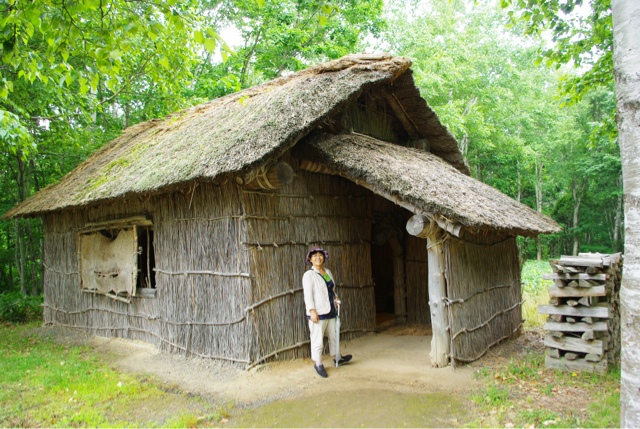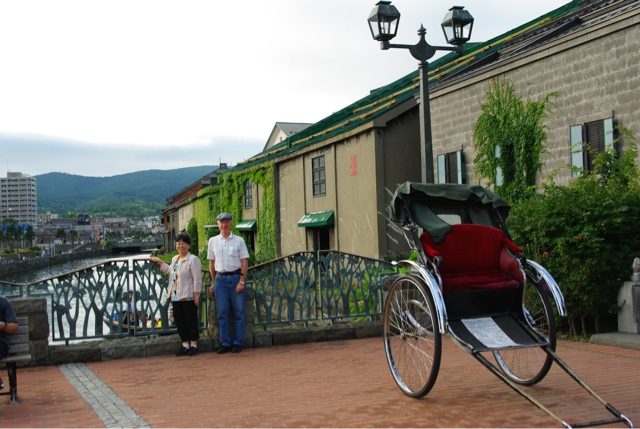Our friend Kenji asked me a little while ago "So what do you think of Japan?". I have been thinking about this for quite sometime and I was able to answer with just one word. The other thing that has been most noticeable about Japanese life is their tolerance of temperature extremes inside their living areas. Both have been especially reinforced by our living here in Ibaraki-Ken during the summer.
Shops such as SoftBank are stifling hot in winter and grocery stores just as in Winnipeg ridiculously cold. Old houses had open beamed attics that probably allowed air flow to keep the building somewhat cool. Now homes have internal ceilings and are probably hot enough to boil water in the attic. This attic heat causes the ceiling to act as a radiant heater. Homes here tend to have no shade trees, no central air, no central heating and this combined with global warming in the summer and global cooling in the winter can make life very uncomfortable. Do people in Canada wear a down filled jacket when cooking in the winter?
We escaped to Hokkaido the last week of July and were gone three weeks which were probably all hot weeks. The two weeks that we have been back are both hot weeks. That means about 34°C during the day and about 28°C at night. Thousands have suffered heat stroke and over a hundred have died.
During the week I have been getting up before 5am and working in the field for one to two hours. Then I take a short break, walk the
dog (already too hot for Muku) and then we have breakfast about 8am. In the evening Muku gets walked just before sunset. During the day we relax as best we can and frequently have the wall air conditioner (Japanese style AC) on from about 3pm to 6pm. Akio Okano works from 6am to about 12:30pm and then has lunch and a siesta until 2:30 or 3pm. He then works on the farm until close to 7pm and it is quite dark at that time (no daylight saving time here). I would have heat stroke every day, if I tried to keep up to him.
What is Japan? Japan is a jungle. In the winter some of the vines become almost invisible, but in summer it is unbelievable. Wisteria vines crawl over the road and vines as thick as your wrist choke trees. The kudzu (legume) vine is alive and well here. It is not quite the pest it has become in countries such as the USA where some nitwit introduced the vine. Here there are enough competitors including farmers that some semblance of control is being maintained. But I suspect if you stood in one spot for an hour you might be entangled by these crazy vines. The photographs show green on green so the kudzu may not show up that well, but they are climbing over everything. Then there are the immense forests of "sugi" or cryptomeria trees which the government here has had planted everywhere. And what is the farmer's first enemy that must be removed before anything can be grown, the many varieties of bamboo.
Click on Jungle to see photographs on Picasa.
Friday 31 August 2012
Thursday 30 August 2012
Komatsu Matsuri
During the period of Obon in Komatsu, two related but different styles of "matsuri" or festivals are taking place. Both involve the inclusion of one or more "shishi" or lion dancers. We saw the one form in which dancers, musicians and about three lion costumed actors performed in parking lot venues. These dances are essentially a Shinto ritual to invoke a good harvest for people in the community.
The second form of which we have a number of photographs has a large lion costume with a long 'train'. Once a year the lion leaves the "jinja" or Shinto shrine and makes the rounds of the town from morning to night. The lion is followed by what appears to be a 'lion tamer' that attempts to coax the lion back to the "jinja". The lion we observed came from the 'Shinzan Jinja'. This shrine, although only 100 meters away from eldest brother's house belongs to a different district than eldest brother's district. Shrines are usually located on an elevated area surrounded by tall "sugi" or cryptomeria trees. Eldest brother's neighbour used to live on the same hill and in a show of respect for the neighbour the lion and dancers pay a visit to the neighbour. Similarly the group makes the rounds of the town visiting various people and getting "sake" or rice wine to drink. You can hear the taiko drummers at various times during the day. Later after dark the lion is finally persuaded to return to the "jinja".
Click on Komatsu Matsuri to see photographs on Picasa.
The second form of which we have a number of photographs has a large lion costume with a long 'train'. Once a year the lion leaves the "jinja" or Shinto shrine and makes the rounds of the town from morning to night. The lion is followed by what appears to be a 'lion tamer' that attempts to coax the lion back to the "jinja". The lion we observed came from the 'Shinzan Jinja'. This shrine, although only 100 meters away from eldest brother's house belongs to a different district than eldest brother's district. Shrines are usually located on an elevated area surrounded by tall "sugi" or cryptomeria trees. Eldest brother's neighbour used to live on the same hill and in a show of respect for the neighbour the lion and dancers pay a visit to the neighbour. Similarly the group makes the rounds of the town visiting various people and getting "sake" or rice wine to drink. You can hear the taiko drummers at various times during the day. Later after dark the lion is finally persuaded to return to the "jinja".
Click on Komatsu Matsuri to see photographs on Picasa.
Obon
In Komatsu Obon takes place from August 13 to August 15. This time is intended to convey respect to one's ancestors. During this time the ancestors come to visit. There are extra decorations in the room where the Buddhist altar is located and at some point a priest pays a visit.
On August 16 the ancestors return. The earlier the family gets to the "tera" or temple and to the family grave site, the better the position of the ancestors in heaven.
Click on Obon to see photographs on Picasa.
On August 16 the ancestors return. The earlier the family gets to the "tera" or temple and to the family grave site, the better the position of the ancestors in heaven.
Click on Obon to see photographs on Picasa.
Home Town Views
The home that we stayed in with Yayoi's parents 30 plus years ago in 1980 and 1983 no longer exists. We went to see the neighbour of the non- existent house who is Yayoi's relative. His father, many many years ago took me for a long walk in the nearby hills. I will never forget.
Big brother Hiroshi lives in the older part of town as can be seen by some of the photographed buildings.
Komatsu's claim to fame is Dahlia Park which used to be an easily accessible park, but now has an entrance gate and admission fees. Next door is a hot spring resort which is also quite new.
Walking from one end of the old town to the other end brings back many memories and we are almost able to get lost. I remember there used to be a department store (I called it the 'S' store) and when Yayoi's mom and we walked into the store and began browsing, I suddenly realized something was happening. All the people in the store realized there was a "gaijin" or foreign person in the store and they were all in shocked motionless silence. This is not likely to happen anymore, but the "gaikokojin" or foreigner is still noticed.
Click on Home Town Views to see photographs on Picasa.
Big brother Hiroshi lives in the older part of town as can be seen by some of the photographed buildings.
Komatsu's claim to fame is Dahlia Park which used to be an easily accessible park, but now has an entrance gate and admission fees. Next door is a hot spring resort which is also quite new.
Walking from one end of the old town to the other end brings back many memories and we are almost able to get lost. I remember there used to be a department store (I called it the 'S' store) and when Yayoi's mom and we walked into the store and began browsing, I suddenly realized something was happening. All the people in the store realized there was a "gaijin" or foreign person in the store and they were all in shocked motionless silence. This is not likely to happen anymore, but the "gaikokojin" or foreigner is still noticed.
Click on Home Town Views to see photographs on Picasa.
Komatsu Family
Yayoi has two brothers and one sister. Yayoi is the youngest sibling. Hiroshi Konno is the eldest brother. Hiroshi and his wife Michiko have two children.
The son Takeshi and has wife Yukari also live in Komatsu, but on the 'new' side of the tracks, quite literally. They have three children.
The daughter Naomi is living with her parents and her two children have both left home. In this home, belonging to eldest brother, you can count on a beautiful flower arrangement in the front entrance and ocha served before you can catch your breathe.
When the neighbour's hear that we are coming food is delivered to the house. As a result of the sashimi Michiko served us and "mochi" or pounded rice provided by a neighbour we had a delicious first dinner. The mochi was served with three different toppings, "natto" or fermented soybeans, "anko" or cooked sweetened red azuki beans and "edamame" or green cooked soybeans which many North Americans are familiar with.
Hiroshi is in his eighties so it is good to be able to see him and Michiko again. On our last night together the five of us went out to a local restaurant and had 'basket meals'.
Click on Komatsu Family to see photographs on Picasa.
The son Takeshi and has wife Yukari also live in Komatsu, but on the 'new' side of the tracks, quite literally. They have three children.
The daughter Naomi is living with her parents and her two children have both left home. In this home, belonging to eldest brother, you can count on a beautiful flower arrangement in the front entrance and ocha served before you can catch your breathe.
When the neighbour's hear that we are coming food is delivered to the house. As a result of the sashimi Michiko served us and "mochi" or pounded rice provided by a neighbour we had a delicious first dinner. The mochi was served with three different toppings, "natto" or fermented soybeans, "anko" or cooked sweetened red azuki beans and "edamame" or green cooked soybeans which many North Americans are familiar with.
Hiroshi is in his eighties so it is good to be able to see him and Michiko again. On our last night together the five of us went out to a local restaurant and had 'basket meals'.
Click on Komatsu Family to see photographs on Picasa.
Haircut
Yayoi and I had been telling each other that the next time we were in Komatsu, Yamagata, we would get haircuts in the shop belonging to the family of Hiroko, Yayoi's childhood friend in Niigata City, Niigata Prefecture. In Komatsu, Yayoi's eldest brother Hiroshi made a phone call and at 1pm we were walking on our way to the barber. Hiroko used to live in the same building as the barber shop when her mother was still doing the barbering. Yayoi and her family were living in a rented place next door.
It was my turn and I sat down. Did I forget to mention, I haven't had a haircut for about forty years? Okay, okay, no wise cracks, just because I cut my own hair.
Hiroko's brother's wife is now doing the barbering. Here I am, my hair has been cut with a scissors only and my hair shampooed. Did I want the area around my eyebrows shaved? No, thank you to this and a number of similar questions. I did allow a shave and I was very well behaved during this procedure. Even Yayoi did not dare to take a photograph at this time, just in case this would cause the straight razor to slip. Oops! After a facial massage and various other applications I was complete. Yayoi's turn. My job probably took three times as much time.
Anyway grapes, ocha and senbei (Japanese crackers) were set before us. Yayoi had a good visit with Hiroko's 96 year old mother. She is supposedly a little senile, but all Yayoi had to do is mention her first name and Hiroko's mother knew immediately that this was Yayoi of the Konno family.
Click on Haircut to see photographs on Picasa.
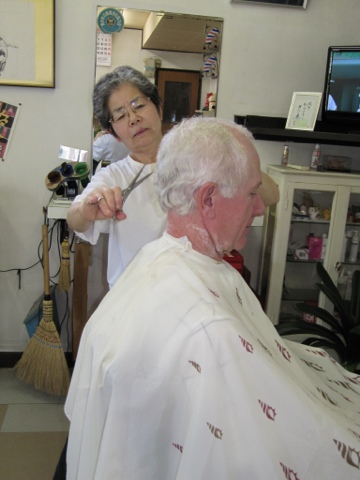

It was my turn and I sat down. Did I forget to mention, I haven't had a haircut for about forty years? Okay, okay, no wise cracks, just because I cut my own hair.
Hiroko's brother's wife is now doing the barbering. Here I am, my hair has been cut with a scissors only and my hair shampooed. Did I want the area around my eyebrows shaved? No, thank you to this and a number of similar questions. I did allow a shave and I was very well behaved during this procedure. Even Yayoi did not dare to take a photograph at this time, just in case this would cause the straight razor to slip. Oops! After a facial massage and various other applications I was complete. Yayoi's turn. My job probably took three times as much time.
Anyway grapes, ocha and senbei (Japanese crackers) were set before us. Yayoi had a good visit with Hiroko's 96 year old mother. She is supposedly a little senile, but all Yayoi had to do is mention her first name and Hiroko's mother knew immediately that this was Yayoi of the Konno family.
Click on Haircut to see photographs on Picasa.


Niigata Ocean Views
On August 14, 2012 (Happy Birthday, Bryan) four of us drove the Niigata coastal highway and saw scenery of breathtaking beauty. Somehow a camera is a very disappointing tool. Scenery is more than a picture as it does not include the breezes, the sound of waves rolling in, the smell of the ocean. Two things we miss seeing in our current address in Ibaraki Prefecture, mountains and proximity to the ocean. Ibaraki is part of the Kanto plain region which is likely one of the largest flat areas in Japan, including the city of Tokyo. Ibaraki Prefecture does have ocean front property, but we are not close to it and it is most likely not nearly as picturesque as what we have seen on the Japan Sea side with its rocks, mountains nearby and that gorgeous water in varying shades of blue (guys only know a handful of colours).
After an interesting lunch Hiroshi and Hiroko drove us inland to the train station in Sakamachi that took us on a slow train ride all the way to Uzen Komatsu train station in Yayoi's home town.
Click on Niigata Ocean Views to see photographs on Picasa.
After an interesting lunch Hiroshi and Hiroko drove us inland to the train station in Sakamachi that took us on a slow train ride all the way to Uzen Komatsu train station in Yayoi's home town.
Click on Niigata Ocean Views to see photographs on Picasa.
Wednesday 29 August 2012
Ito Mansion Museum
On August 14, 2012 we went to see the Northern Culture Museum outside of Niigata. Since the mid 1800's and especially since the Meiji Restoration the Ito family became major agricultural land owners in Niigata Prefecture. But in 1946 as a result of the Land Reform Act they donated the mansion and works of art to the Museum. They were one of the largest landowners in Japan prior to this. The home and outbuildings were built not long after 1880 and provide a graphic description of how 'the other half' lived. Tourists in Japan need to enjoy gardens such as this. Today maintaining such gardens privately has become prohibitively expensive, especially the pruning required to maintain the unique tree shapes.
We had a tempura and soba (buckwheat) noodle lunch on the grounds. After we ambled over to another building and with coupons Hiroko received from a friend she met working here, we had a delicious azuki bean (zenzai) and ice cream dessert.
Click on Ito Mansion Museum to see photographs on Picasa.
We had a tempura and soba (buckwheat) noodle lunch on the grounds. After we ambled over to another building and with coupons Hiroko received from a friend she met working here, we had a delicious azuki bean (zenzai) and ice cream dessert.
Click on Ito Mansion Museum to see photographs on Picasa.
Niigata Hosts
On August 12, 2012 at 0600h we met Hiroko who is a childhood friend of Yayoi. They have known each other since they were four years old. About that time Hiroko's parents had a barbershop which was also their home. Yayoi's family rented the house next door. Hiroko's brother's wife is still operating the barber shop and one of the future BLOGs will show Yayoi and I getting haircuts in the barbershop in Komatsu, Yamagata.
Hiroshi and Hiroko have two daughters, the younger with her husband and three children are living together with them. I suspect there are not as many three generation families as in the past. What we saw of this family impressed us favourably. There is a teenage son dealing with hormones and a brain that is reorganizing to deal with life's challenges, a much younger son that admires big brother, while big brother pretends to just barely tolerate little brother. The little sister we suspect controls everything and everyone around her.
We were treated graciously by the entire family. Little brother, towards the end of our brief visit, wondered why we couldn't stay with them permanently. Two mornings at 0630h we joined a group that we suspect Hiroko organized. It consisted of young grandchildren and adults that were mostly grandparents. From all directions a group of twenty to thirty people converged on a small park nearby. Hiroko brings a small radio which broadcasts instructions for performing early morning "taiso" or exercises. The second morning at one point in my clumsy attempts at following the rest of the group I glanced at Hiroko and granddaughter and noticed that little sister was watching me intently. I just knew I was failing that evaluation. Later on the walk back home I told Yayoi about this and asked her to ask little sister whether she thought I had been doing okay. Little sister very tactfully replied "I don't know what you are talking about".
Click on Niigata Hosts to see photographs on Picasa.
Hiroshi and Hiroko have two daughters, the younger with her husband and three children are living together with them. I suspect there are not as many three generation families as in the past. What we saw of this family impressed us favourably. There is a teenage son dealing with hormones and a brain that is reorganizing to deal with life's challenges, a much younger son that admires big brother, while big brother pretends to just barely tolerate little brother. The little sister we suspect controls everything and everyone around her.
We were treated graciously by the entire family. Little brother, towards the end of our brief visit, wondered why we couldn't stay with them permanently. Two mornings at 0630h we joined a group that we suspect Hiroko organized. It consisted of young grandchildren and adults that were mostly grandparents. From all directions a group of twenty to thirty people converged on a small park nearby. Hiroko brings a small radio which broadcasts instructions for performing early morning "taiso" or exercises. The second morning at one point in my clumsy attempts at following the rest of the group I glanced at Hiroko and granddaughter and noticed that little sister was watching me intently. I just knew I was failing that evaluation. Later on the walk back home I told Yayoi about this and asked her to ask little sister whether she thought I had been doing okay. Little sister very tactfully replied "I don't know what you are talking about".
Click on Niigata Hosts to see photographs on Picasa.
Niigata Yakitori Ya
On August 12, 2012 Hiroshi and Hiroko took us to a public bath and later we went to a Yakitori Ya, which is essentially a chicken 'shish kabob' style place. We sat at a bar with the chef and as many as three employees on the other side. We could order items and they would then be prepared in front of us. The grill being used was a double electric grill, which I found a little unusual. Apparently many such places in Niigata have had to close, but this one has remained popular and does a good business.
Being there with friends and being in an atmosphere where the chef appeared to be quite cheerful and kept up a running banter with his employees, kept us amused. I found the banter to be quite entertaining.
Of course the food was interesting (read chicken skins) and quite delicious.
Click on Niigata Yakitori Ya to see photographs on Picasa.
Being there with friends and being in an atmosphere where the chef appeared to be quite cheerful and kept up a running banter with his employees, kept us amused. I found the banter to be quite entertaining.
Of course the food was interesting (read chicken skins) and quite delicious.
Click on Niigata Yakitori Ya to see photographs on Picasa.
Bamboo House
At 0600h Hiroshi and Hiroko picked us up at the ferry. We went for breakfast and then to the seashore so Yayoi and I could dip our feet in the Japan Sea. After we went to the river to see a bamboo house. While we were there we were told that of all the bridges that cross the river the only one that survived an earthquake many years ago is one that was handmade, without machinery.
The bamboo house was designed by an artist, Wang Wen-Chih in 2012 entitled 'Phoenix From the Flames'. The raised floor, walls and roof are all not water or air proof and in the hot morning sun the resultant air flow kept the house quite cool. It is remarkably appealing to the eye and very well built, making one think that it could have practical applications.
The bamboo house was designed by an artist, Wang Wen-Chih in 2012 entitled 'Phoenix From the Flames'. The raised floor, walls and roof are all not water or air proof and in the hot morning sun the resultant air flow kept the house quite cool. It is remarkably appealing to the eye and very well built, making one think that it could have practical applications.
Tuesday 28 August 2012
Ferry from Otaru to Niigata
The morning of August 11, 2012 Katsuo and Sumiko Kimura picked us up and drove us from Sapporo to the city of Otaru to catch the 10:30am ferry called Yuukari to arrive in Niigata at 0600h the next morning. We have taken overnight buses in Japan and been on ferries before, but this was the first experience with an overnight ferry.
We had attempted to purchase the cheapest tickets, but these were sold out, so Katsuo on our behalf purchased ones a level more expensive. There are four types of passenger accommodation. The first has about 8 people sleeping in a common room on the floor. The second, which we had tickets for provided a very small cubicle for each passenger, closed at one end by a cloth curtain. These were both on the third or entry level. The fourth level had cabins for passengers, while the fifth floor had suites. Washrooms on the third floor were public ones. There were public baths aboard the ship as well. This is one aspect we were simply not prepared for. We did not have body wash, shampoo or towels. Most of the other passengers were well aware of what was required and later in the evening the hallway railings were entirely covered in wet towels.
We were able to watch movies in the ship's theatre. A juggler entertained the kids (and adults) in a cafe area. Later Yayoi and I ate in the ship's restaurant. The food was edible, but nothing to brag about.
Neither one of us slept too much and at 5am many people were up getting themselves ready for disembarking in Niigata. Sure enough, with typical Japanese punctuality the Yuukari docked in Niigata at precisely 0600h where Yayoi's junior high school friend Hiroko and her husband Hiroshi were waiting for us.
Click on Overnight Ferry from Otaru to Niigata to see photographs on Picasa.
We had attempted to purchase the cheapest tickets, but these were sold out, so Katsuo on our behalf purchased ones a level more expensive. There are four types of passenger accommodation. The first has about 8 people sleeping in a common room on the floor. The second, which we had tickets for provided a very small cubicle for each passenger, closed at one end by a cloth curtain. These were both on the third or entry level. The fourth level had cabins for passengers, while the fifth floor had suites. Washrooms on the third floor were public ones. There were public baths aboard the ship as well. This is one aspect we were simply not prepared for. We did not have body wash, shampoo or towels. Most of the other passengers were well aware of what was required and later in the evening the hallway railings were entirely covered in wet towels.
We were able to watch movies in the ship's theatre. A juggler entertained the kids (and adults) in a cafe area. Later Yayoi and I ate in the ship's restaurant. The food was edible, but nothing to brag about.
Neither one of us slept too much and at 5am many people were up getting themselves ready for disembarking in Niigata. Sure enough, with typical Japanese punctuality the Yuukari docked in Niigata at precisely 0600h where Yayoi's junior high school friend Hiroko and her husband Hiroshi were waiting for us.
Click on Overnight Ferry from Otaru to Niigata to see photographs on Picasa.
Santoku Rokumi Restaurant
On August 10, 2012 our last evening in Sapporo, Hokkaido, Katsuo and Sumiko Kimura picked us up by taxi and we went to the above named restaurant.
Reservations must be made well in advance as the meal is "omakase" style. This is like being invited to someone's home and having a multiple course meal served to you one course at a time. The major difference between this and a multi-course meal you would get at an "onsen" or hot spring resort is that the latter tends to serve multiple dishes in two to three sets as opposed to individual dishes.
We have had similar experiences before including Winnipeg's Gluttons where Makoto Ono served us an "omakase" style meal. Previously in Japan I remember going to a tofu restaurant where many variations of tofu were served to us, not necessarily one course at a time. But what became embedded in my memory about that occasion is the timing of the service. We were in a private room with sliding doors all around us. Whenever you completed a dish, someone appeared to remove the plates and others were brought in. I have never witnessed such impeccable timing before.
Anyway back to this occasion the chef who is married to a relative of the Kimura's, would come in early in the morning to begin some preparations for the few groups of guests who would be arriving that evening. Because it was summer where practical the dishes were served cold. These dishes were prepared and stored until the evening. The few hot dishes were efficiently prepared on a charcoal grill and gas burners behind the bar the four of us sat at. The dessert was created by the chef's wife, whom we regrettably did not meet.
As a result of all the work that had taken place before we got there, we never had to worry about choosing from a menu and we did not have to wait for food to be prepared. And as can be expected the food was "oishkata" or delicious.
"Omakase" is the ultimate Japanese way to eat.
Click on Santoku Rokumi Restaurant to see photographs on Picasa.
Reservations must be made well in advance as the meal is "omakase" style. This is like being invited to someone's home and having a multiple course meal served to you one course at a time. The major difference between this and a multi-course meal you would get at an "onsen" or hot spring resort is that the latter tends to serve multiple dishes in two to three sets as opposed to individual dishes.
We have had similar experiences before including Winnipeg's Gluttons where Makoto Ono served us an "omakase" style meal. Previously in Japan I remember going to a tofu restaurant where many variations of tofu were served to us, not necessarily one course at a time. But what became embedded in my memory about that occasion is the timing of the service. We were in a private room with sliding doors all around us. Whenever you completed a dish, someone appeared to remove the plates and others were brought in. I have never witnessed such impeccable timing before.
Anyway back to this occasion the chef who is married to a relative of the Kimura's, would come in early in the morning to begin some preparations for the few groups of guests who would be arriving that evening. Because it was summer where practical the dishes were served cold. These dishes were prepared and stored until the evening. The few hot dishes were efficiently prepared on a charcoal grill and gas burners behind the bar the four of us sat at. The dessert was created by the chef's wife, whom we regrettably did not meet.
As a result of all the work that had taken place before we got there, we never had to worry about choosing from a menu and we did not have to wait for food to be prepared. And as can be expected the food was "oishkata" or delicious.
"Omakase" is the ultimate Japanese way to eat.
Click on Santoku Rokumi Restaurant to see photographs on Picasa.
Monday 27 August 2012
Menno Village Japan
On August 10, 2012 as a result of Yayoi expressing an interest, Katsuo Kimura went to a lot of effort to contact and get permission for him to bring us to see Menno Village in Hokkaido.
The place is being run by Raymond Epp with his wife Akiko. They have four sons. Raymond does most of the machinery related work and at least six people are involved in other aspects of the operation. The property is a conglomeration of various parcels of land in the vicinity that have been purchased or rented. Land becomes available when elderly farmers have no one to pass the land on to and they are incapable of carrying on. The land is situated next to hills so that some of the fields had to be 'bulldozed' from corner to corner to level the ground and prepare it for the growth of rice. This means that one corner is more fertile than the other. Chemicals are avoided for weed and pest control. There is no shortage of work so we were careful not to overstay our welcome as three sets of boots and gloves might have appeared for our use.
Ray and Akiko have a number of Winnipeg, Manitoba, Canada connections. Although brought up in the USA, Ray met Akiko in Winnipeg and was one of the people instrumental in the creation of Tall Grass Prairie Bread bakery in Winnipeg. The bakery mills its own grain to produce the flour used in its baked goods. A similar process s used at Menno Village and we can attest to the fact that the bread is "oishi" or delicious as Katsuo bought some and had us try it.
Free trade closed the flour mills in Manitoba and the bakery in Winnipeg was eventually the only mill. This came to the attention of the Canadian Wheat Board and Ray was 'hauled up on the carpet' to defend their milling without the requisite paperwork in place. The unimaginably small scale of the mill involved allowed the bakery to continue operations, along with a sample of the product supplied to the CWB. Bureaucrats!
As one of the photographs demonstrates many homes in Hokkaido have chimneys unlike the rest of Japan. In this case Akiko's father an engineer designed a wood fired under floor heating system. When someone forgets to bring home the wood, alternative fuels can be used.
Click on Menno Village to see photographs on Picasa.
The place is being run by Raymond Epp with his wife Akiko. They have four sons. Raymond does most of the machinery related work and at least six people are involved in other aspects of the operation. The property is a conglomeration of various parcels of land in the vicinity that have been purchased or rented. Land becomes available when elderly farmers have no one to pass the land on to and they are incapable of carrying on. The land is situated next to hills so that some of the fields had to be 'bulldozed' from corner to corner to level the ground and prepare it for the growth of rice. This means that one corner is more fertile than the other. Chemicals are avoided for weed and pest control. There is no shortage of work so we were careful not to overstay our welcome as three sets of boots and gloves might have appeared for our use.
Ray and Akiko have a number of Winnipeg, Manitoba, Canada connections. Although brought up in the USA, Ray met Akiko in Winnipeg and was one of the people instrumental in the creation of Tall Grass Prairie Bread bakery in Winnipeg. The bakery mills its own grain to produce the flour used in its baked goods. A similar process s used at Menno Village and we can attest to the fact that the bread is "oishi" or delicious as Katsuo bought some and had us try it.
Free trade closed the flour mills in Manitoba and the bakery in Winnipeg was eventually the only mill. This came to the attention of the Canadian Wheat Board and Ray was 'hauled up on the carpet' to defend their milling without the requisite paperwork in place. The unimaginably small scale of the mill involved allowed the bakery to continue operations, along with a sample of the product supplied to the CWB. Bureaucrats!
As one of the photographs demonstrates many homes in Hokkaido have chimneys unlike the rest of Japan. In this case Akiko's father an engineer designed a wood fired under floor heating system. When someone forgets to bring home the wood, alternative fuels can be used.
Click on Menno Village to see photographs on Picasa.
Boys Be Ambitious
William S. Clark became president of Massachusetts Agricultural College and worked hard to establish educational opportunities for farmers whom he felt were being overlooked. His work brought him to the attention of Japanese authorities who persuaded him to aid in establishing Sapporo Agricultural College, now Hokkaido University. He was there a mere eight months from 1876 to 1877 concurrently with his presidency of the college in the USA, but had a major impact on both the college as well as on many other aspects of life in the pioneer territory of Hokkaido. He is probably one of the more significant influences which today make Hokkaido appear more 'american' than any other part of Japan.
The title of this BLOG is guaranteed to be misinterpreted by most readers.
The students of the college were be exhorted in an address to them, to do their utmost in the service of their fellow countrymen and not for selfish purposes.
Click on Boys Be Ambitious to see photographs on Picasa.
The title of this BLOG is guaranteed to be misinterpreted by most readers.
The students of the college were be exhorted in an address to them, to do their utmost in the service of their fellow countrymen and not for selfish purposes.
Click on Boys Be Ambitious to see photographs on Picasa.
Shiretoko Oshinkoshin Falls
After dropping most of the passengers on the bus off for their cruise we continued on to the falls. Like so many falls these were quite beautiful and the view changed every few meters on the walkway.
Click on Oshinkoshin Falls to see photographs on Picasa.
Click on Oshinkoshin Falls to see photographs on Picasa.
Shiretoko Goto Lakes
On August 8, 2012 the bus picked us up at the hotel and we were taken to see a number of sights prior to being transported to the train station. At the Goto Lakes site we went for a walk on a well constructed wooden walkway over a marshy area. The breezes pushed the fog in and out as we progressed on the walkway. We saw Ezo "Shika" or deer bedded down or eating water lily leaves as published previously. The scenery is quite beautiful and we were thankful for the boardwalk.
Click on Shiretoko Goto Lakes to see photographs on Picasa.
Click on Shiretoko Goto Lakes to see photographs on Picasa.
Hanabi or fireworks
We interrupt this travelogue to bring you a taste of the most astounding light show we have ever seen. We have them in Canada, but I have never seen anything on the scale we observed here and this is a 'rural' area.
The travelogue of our trip to Hokkaido is not complete, but someone whose initials are KY strongly suggested I interrupt the travelogue and BLOG about "Hanabi" where the word "hana" means flower.
Our host Okano-san mentioned that people were reserving spots as much as a week in advance. So he had reserved one for his gang as well.
It is August 25, 2012, Saturday. Because it is so hot (hottest summer people can remember) I got up at 4:30am and went to do some gardening. About 6am there were a number of explosions down below and I wasn't sure whether another war had started or whether the nearby freeway was blasting away soil for the road. Then about 7am as I was walking Muko there was an announcement over the villages loudspeaker (location still unknown), probably concerning the evening's events. At 12 noon there were some more explosions.
On weekends we usually see more people in the village, for example, children coming back to see parents or possibly looking after the empty family home. But this weekend there appeared to be more activity in the village and unfamiliar people. Traffic patterns on our few streets appeared to have changed as well. Late afternoon there was another announcement over the local loudspeaker.
Prior to 6pm Kenji and his sister Etsuko showed up on our farm yard. Then Shigeko's mother and Akio's older brother arrived on the property. At about 6pm we piled into three vehicles, although two of us protested that we could walk. In our ignorance we assumed Akio had reserved a spot up on the edge of our plateau near the "hatake" or field. We drove down to the 'valley' and parked on the edge of the dike next to the river that runs to Lake Kasumigaura.
The story was that we would be eating "onegiri" or rice balls, which was true along with a number of other delicious dishes, for one, "karage" or fried chicken pieces.
There were cars and people everywhere on the little roads surrounding the "tanbo" or rice fields, as well as back up on the plateau we call home.
Then at 7pm after the sun had set we set our sights in the direction of Edosaki and the extravaganza began. At one point early in the evening the "hanabi" paused and I assumed the airplane flying in the area on its way to Narita airport had to be allowed for. But watching many more planes later without any cessation of the fireworks, I jokingly suggested that the pilots were saying to their passengers "Welcome to Japan, the land of fireworks". It appeared as though they were deliberately flying through the danger zone.
Apparently there is a fireworks factory in Ibaraki Prefecture, but I suspect the factory was empty after that evening. There must be some very skilled artistic craftsmen in this factory. There were supposedly ten thousand individual fireworks that were fired off and considering the complexity of each, assuming a cost of at least $100 each - do the math.
This was no ten minute show, but carried on until 9pm with one interlude at which time floodlights came on in the distance and we believe the speeches began.
There were a variety of flowers, faces, even a Mickey Mouse being created ephemerally in the sky. There were plenty of 'ohhs and ahhs' from our little group. I estimate I took about 250 photographs of which I deleted many and then selected a few to publish. Photographing "hanabi" is not easy, although even with a tripod knowing which area of sky to focus on would have been difficult.
Towards the end we had a traffic jam, believe it or not as cars from Edosaki came back to our area and groups such as ours started leaving the rice fields to go back home. Our group went back to the Okano's where we had some of that delicious "suika" or watermelon that my favourite farmer has been growing. What a wonderful evening, with no admission fee nor any parking charge.
Click on Hanabi to see photographs on Picasa.
The travelogue of our trip to Hokkaido is not complete, but someone whose initials are KY strongly suggested I interrupt the travelogue and BLOG about "Hanabi" where the word "hana" means flower.
Our host Okano-san mentioned that people were reserving spots as much as a week in advance. So he had reserved one for his gang as well.
It is August 25, 2012, Saturday. Because it is so hot (hottest summer people can remember) I got up at 4:30am and went to do some gardening. About 6am there were a number of explosions down below and I wasn't sure whether another war had started or whether the nearby freeway was blasting away soil for the road. Then about 7am as I was walking Muko there was an announcement over the villages loudspeaker (location still unknown), probably concerning the evening's events. At 12 noon there were some more explosions.
On weekends we usually see more people in the village, for example, children coming back to see parents or possibly looking after the empty family home. But this weekend there appeared to be more activity in the village and unfamiliar people. Traffic patterns on our few streets appeared to have changed as well. Late afternoon there was another announcement over the local loudspeaker.
Prior to 6pm Kenji and his sister Etsuko showed up on our farm yard. Then Shigeko's mother and Akio's older brother arrived on the property. At about 6pm we piled into three vehicles, although two of us protested that we could walk. In our ignorance we assumed Akio had reserved a spot up on the edge of our plateau near the "hatake" or field. We drove down to the 'valley' and parked on the edge of the dike next to the river that runs to Lake Kasumigaura.
The story was that we would be eating "onegiri" or rice balls, which was true along with a number of other delicious dishes, for one, "karage" or fried chicken pieces.
There were cars and people everywhere on the little roads surrounding the "tanbo" or rice fields, as well as back up on the plateau we call home.
Then at 7pm after the sun had set we set our sights in the direction of Edosaki and the extravaganza began. At one point early in the evening the "hanabi" paused and I assumed the airplane flying in the area on its way to Narita airport had to be allowed for. But watching many more planes later without any cessation of the fireworks, I jokingly suggested that the pilots were saying to their passengers "Welcome to Japan, the land of fireworks". It appeared as though they were deliberately flying through the danger zone.
Apparently there is a fireworks factory in Ibaraki Prefecture, but I suspect the factory was empty after that evening. There must be some very skilled artistic craftsmen in this factory. There were supposedly ten thousand individual fireworks that were fired off and considering the complexity of each, assuming a cost of at least $100 each - do the math.
This was no ten minute show, but carried on until 9pm with one interlude at which time floodlights came on in the distance and we believe the speeches began.
There were a variety of flowers, faces, even a Mickey Mouse being created ephemerally in the sky. There were plenty of 'ohhs and ahhs' from our little group. I estimate I took about 250 photographs of which I deleted many and then selected a few to publish. Photographing "hanabi" is not easy, although even with a tripod knowing which area of sky to focus on would have been difficult.
Towards the end we had a traffic jam, believe it or not as cars from Edosaki came back to our area and groups such as ours started leaving the rice fields to go back home. Our group went back to the Okano's where we had some of that delicious "suika" or watermelon that my favourite farmer has been growing. What a wonderful evening, with no admission fee nor any parking charge.
Click on Hanabi to see photographs on Picasa.
Saturday 25 August 2012
Gumi Cherries
One of the reasons we are in Japan is to have Yayoi reconnect with many aspects of a life she has not known intimately for two thirds of her lifetime. I suspect her time here is reacquainting her with her mother tongue and life style. We have also been eating a number of foods, especially wild vegetables that are not available in Canada. As we explored the area near the Shiretoko Hotel, she spotted a tree on the other side of the hotel parking lot with what appeared to be red plum shaped cherries. She calls them "gumi" and thought that they had a tart taste based on childhood memories. One thing I cannot always appreciate is the Japanese sensitivity to sour foods. Any apple that is not bland tasting is "tsupi" or sour. Yet the variety of pickled and fermented foods they eat is astounding.
I tasted the "gumi" and found them to be somewhat bland.
I tasted the "gumi" and found them to be somewhat bland.
Ezo Shika or Hokkaido Deer
Ezo, Yezo or Yeso are old expressions for the island of Hokkaido. The deer are different than the ones seen in the rest of Japan. Animals such as the bear also differ as the Hokkaido version is more like the Alaskan or Kodiak brown bear, while Honshu has bears more like the Canadian black bear.
The deer have become too numerous on the Shiretoko Peninsula, but we did our part in curbing their growth by consuming some of their meat. It was quite good. Probably due to their large numbers, many of the deer have become quite comfortable with the presence of the 'top predator'.
Click on Ezo Shika to see photographs on Picasa.
The deer have become too numerous on the Shiretoko Peninsula, but we did our part in curbing their growth by consuming some of their meat. It was quite good. Probably due to their large numbers, many of the deer have become quite comfortable with the presence of the 'top predator'.
Click on Ezo Shika to see photographs on Picasa.
Friday 24 August 2012
Shiretoko Peninsula
The Shiretoko Peninsula is located on the east side or pacific Ocean side of Hokkaido. The Sea of Okhotsk is located north of the peninsula and is noted for sending ice floes to the shores of the peninsula. It also tempers the climate which tends to be significantly cooler than other parts of Japan. The Pacific Ocean side of Honshu has a climate moderated by warm ocean currents flowing north.
August 7, 2012 the Shiretoko Hotel shuttled us to the waterfront of Utoro Port where we boarded the Aurora II which cruised along the more northerly shore of the peninsula. We were unable to see the very tip as the captain thought the water was too rough there. But regardless the scenery we did see was beautiful and cannot be seen except by boat as there are no roads to the distal portion of the peninsula.
The first photograph below is of Kashuni Falls.
August 8, 2012 after we checked out of the hotel the bus took us to see a number of scenic sights including Lake Mashu-ko in Akan National Park which is reputed to be a breathtakingly beautiful lake. We have been relatively fortunate with most of our sight seeing but this lake was entirely enshrouded in fog. There is a photograph of us in front of 'nothing' which I simply cannot publish.
Click on Shiretoko Peninsula to see photographs on Picasa.
August 7, 2012 the Shiretoko Hotel shuttled us to the waterfront of Utoro Port where we boarded the Aurora II which cruised along the more northerly shore of the peninsula. We were unable to see the very tip as the captain thought the water was too rough there. But regardless the scenery we did see was beautiful and cannot be seen except by boat as there are no roads to the distal portion of the peninsula.
The first photograph below is of Kashuni Falls.
August 8, 2012 after we checked out of the hotel the bus took us to see a number of scenic sights including Lake Mashu-ko in Akan National Park which is reputed to be a breathtakingly beautiful lake. We have been relatively fortunate with most of our sight seeing but this lake was entirely enshrouded in fog. There is a photograph of us in front of 'nothing' which I simply cannot publish.
Click on Shiretoko Peninsula to see photographs on Picasa.
Sulphur Mountain
Geologically speaking Japan is a very active country. Continental drift causes daily earthquakes. Every so many years a new volcano springs up unexpectedly. There are places in Japan where "onsen" or hot spring resorts are functioning and people are forbidden from drilling into the ground near these places. Why, I am not quite sure? Is it the competition factor or are the authorities afraid someone may awaken a 'sleeping dragon'?
On the last portion of our trip to Shiretoko Peninsula on August 6, 2012, the tour bus let us off in an area that at first glance resembled the Columbia ice fields of the Canadian Rockies minus the ice. In front of us lay a vast area of barren rock and further up the slope we could see yellow areas and areas that appeared to be spouting steam or smoke. As we approached we could hear a loud hissing sound emanating from some of the yellow coloured areas. Dry steam was spewing out of the rocks and in other areas there were small pools of hot water and steam was bubbling through the water.
The next day on a boat cruise up one side of Shiretoko Peninsula we went by an area where the water was tinged a yellow colour near the shoreline. This happened to be the other side of the same mountains we had stopped by yesterday. A relatively large waterfall was coming down the mountain emptying hot sulphur bearing water into the ocean. For once our species of two legged primate could not take responsibility for polluting.
Click on Hot Sulphur to see photographs on Picasa.
On the last portion of our trip to Shiretoko Peninsula on August 6, 2012, the tour bus let us off in an area that at first glance resembled the Columbia ice fields of the Canadian Rockies minus the ice. In front of us lay a vast area of barren rock and further up the slope we could see yellow areas and areas that appeared to be spouting steam or smoke. As we approached we could hear a loud hissing sound emanating from some of the yellow coloured areas. Dry steam was spewing out of the rocks and in other areas there were small pools of hot water and steam was bubbling through the water.
The next day on a boat cruise up one side of Shiretoko Peninsula we went by an area where the water was tinged a yellow colour near the shoreline. This happened to be the other side of the same mountains we had stopped by yesterday. A relatively large waterfall was coming down the mountain emptying hot sulphur bearing water into the ocean. For once our species of two legged primate could not take responsibility for polluting.
Click on Hot Sulphur to see photographs on Picasa.
Ayers Rock Cafe
Sunday, August 5, 2012 after seeing the Kimura's condo we walked down the hill to a second story cafe for dinner. It was being operated by a tall Australian and his Japanese wife. The two met in Australia and circumstances were such that they came back to Japan. They have a four year old son and another child 'on the way'. They operate an English language school and the cafe some evenings. I believe on this occasion they welcomed us due to the Kimura's being friends of theirs. The owners of the building they are using to conduct business were also present for dinner this evening.
We had a great time and ate some unusual creations when compared to standard Japanese cuisine. Lamb was barbecued for us on the patio outside and this combined with a stew, salad and bread made a very satisfying evening. It was like being invited out to a friend's barbecue or a family get together.
Click on Ayers Rock Cafe to see photographs on Picasa.
We had a great time and ate some unusual creations when compared to standard Japanese cuisine. Lamb was barbecued for us on the patio outside and this combined with a stew, salad and bread made a very satisfying evening. It was like being invited out to a friend's barbecue or a family get together.
Click on Ayers Rock Cafe to see photographs on Picasa.
Our Sapporo Hosts
We have met a lot of incredible and incredibly welcoming people in Japan. And there may be some truth to the expression the colder the place you live in the warmer you are. Okay, so I just made that up, but? Katsuo and Sumiko Kimura went out of their way to see that we enjoyed Hokkaido.
Yayoi knew Katsuo in high school, but he didn't stay long, as he decided on a career in the military. Since then we have seen him a couple of times at class reunions.
Katsuo worked as a strategist in the military and here he met his 'wife to be' who worked as a nurse for the military. They are both currently retired, have grandchildren and live in a beautiful "mansion" or condo in Sapporo.
Is there anyone we meet who leads a normal (boring) existence? These people go deep sea diving, he golfs, belongs to a "katana" club, she belongs to a photography group. He has a navigation license for boats.
We suspect they own a time share at Resuto Resort where we stayed for a night in a two story luxury suite. We were given vouchers that he had received from a friend that allowed us to stay in the Sapporo e-Hotel for five nights at no charge.
He drove us all over the countryside making whatever arrangements were necessary. Most of the time she was also able to come. We didn't make things any easier for her, by transmitting the summer flu/cold to her that we were still shaking off.
There is no way we will be able to repay this or any of the many others who have treated us so graciously in this country. Probably if we ever get to Narita "kuko" or airport we will be held back for payments owing.
Yayoi knew Katsuo in high school, but he didn't stay long, as he decided on a career in the military. Since then we have seen him a couple of times at class reunions.
Katsuo worked as a strategist in the military and here he met his 'wife to be' who worked as a nurse for the military. They are both currently retired, have grandchildren and live in a beautiful "mansion" or condo in Sapporo.
Is there anyone we meet who leads a normal (boring) existence? These people go deep sea diving, he golfs, belongs to a "katana" club, she belongs to a photography group. He has a navigation license for boats.
We suspect they own a time share at Resuto Resort where we stayed for a night in a two story luxury suite. We were given vouchers that he had received from a friend that allowed us to stay in the Sapporo e-Hotel for five nights at no charge.
He drove us all over the countryside making whatever arrangements were necessary. Most of the time she was also able to come. We didn't make things any easier for her, by transmitting the summer flu/cold to her that we were still shaking off.
There is no way we will be able to repay this or any of the many others who have treated us so graciously in this country. Probably if we ever get to Narita "kuko" or airport we will be held back for payments owing.
Thursday 23 August 2012
Impressions of Hokkaido and Sapporo
It is a land of very plain homes especially in the countryside. Woodpiles for winter heating are evident along with presence of double paned windows and a substantial number of homes with chimneys which I have seen elsewhere in Japan. The farmlands are on a much larger scale than the rest of Japan with fields that tend to be more regular in shape when allowed by the mountains.
Although only a narrow strip of ocean separates Hokkaido from Honshu, at times the temperatures on Hokkaido can be ten degrees cooler than Ibaraki where Yayoi and I are currently doing a meltdown like butter. At 28°C we feel cool.
It is a very industrious area and there appear to be a variety of people here, probably as the result of pioneering by people from various parts of Japan further south.
Sapporo is one of the larger cities in Japan, but unlike cities such as Tokyo it gives the impression of design or organization. The streets are generally wide and some have central boulevards. An interesting feature of Sapporo along with a number of other cities such as Kagoshima and Hakodate is the presence of streetcars. These were phased out in Winnipeg in the 1950's, but I suspect they may still be a good idea.
It is a cosmopolitan city with the visible presence of foreigners and a significant non-Japanese Asian population.
It appears to be a new vibrant city. It is irregular in shape conforming to depressions between mountains. The suburban areas with single family homes that tend to predominate in most Canadian cities are not that evident here.
Click on Hokkaido And Sapporo to see photographs on Picasa.
Although only a narrow strip of ocean separates Hokkaido from Honshu, at times the temperatures on Hokkaido can be ten degrees cooler than Ibaraki where Yayoi and I are currently doing a meltdown like butter. At 28°C we feel cool.
It is a very industrious area and there appear to be a variety of people here, probably as the result of pioneering by people from various parts of Japan further south.
Sapporo is one of the larger cities in Japan, but unlike cities such as Tokyo it gives the impression of design or organization. The streets are generally wide and some have central boulevards. An interesting feature of Sapporo along with a number of other cities such as Kagoshima and Hakodate is the presence of streetcars. These were phased out in Winnipeg in the 1950's, but I suspect they may still be a good idea.
It is a cosmopolitan city with the visible presence of foreigners and a significant non-Japanese Asian population.
It appears to be a new vibrant city. It is irregular in shape conforming to depressions between mountains. The suburban areas with single family homes that tend to predominate in most Canadian cities are not that evident here.
Click on Hokkaido And Sapporo to see photographs on Picasa.
Wednesday 22 August 2012
Hokkaido or Canada
It has been suggested that Hokkaido is like Canada and that as a result I would like that part of Japan. Hokkaido has a number of features which make it more like Manitoba, Canada than other parts of Japan. But it is still a jungle like the rest of Japan and overall has a warmer climate and mountains. Speaking of jungle, if I had to sum up this trip to Japan in one word I would say 'jungle'. Since I had never been in Japan in summer before I was unable to appreciate how things grow here and how farmers have to beat back the jungle to grow crops.
The first thing I saw upon exiting the under ocean tunnel to Hokkaido was the presence of birch trees which I had not seen before. The roads and freeways tend to appear more spacious, organized and drivable than the rest of Japan. In case I have not mentioned this before, the side mirrors on many cars fold against the car with the press of a button. I wonder why ;) Some of the scenery we saw of forests or rivers reminded us of Manitoba. The trees were not as tall as other areas of Japan and the rivers were not all controlled with concrete.
The farms and farm yards are a bit like Manitoba, but where in Manitoba would you see large solar installations? Shame on our government for not encouraging wind and solar power in our back yards. As well in Manitoba we would not see greenhouses as we do here. Some of the crops are similar and the fields in Hokkaido are quite large. A shame that we use cane sugars in Manitoba when we used to grow sugar beets. Sugar beets are a major crop in Hokkaido.
Click on Canada Or Hokkaido to see photographs on Picasa.
The first thing I saw upon exiting the under ocean tunnel to Hokkaido was the presence of birch trees which I had not seen before. The roads and freeways tend to appear more spacious, organized and drivable than the rest of Japan. In case I have not mentioned this before, the side mirrors on many cars fold against the car with the press of a button. I wonder why ;) Some of the scenery we saw of forests or rivers reminded us of Manitoba. The trees were not as tall as other areas of Japan and the rivers were not all controlled with concrete.
The farms and farm yards are a bit like Manitoba, but where in Manitoba would you see large solar installations? Shame on our government for not encouraging wind and solar power in our back yards. As well in Manitoba we would not see greenhouses as we do here. Some of the crops are similar and the fields in Hokkaido are quite large. A shame that we use cane sugars in Manitoba when we used to grow sugar beets. Sugar beets are a major crop in Hokkaido.
Click on Canada Or Hokkaido to see photographs on Picasa.
Katana or Japanese Sword
Many people especially of the male persuasion desire to put their hands on these weapons.
Saito-san or the "soba" lady (buckwheat) as I call her took her husband's katana and hid it somewhere in their capacious home. He has not been able to find it. Sumiko seen in the background of one of the photographs did not make any effort to disguise her disapproval of these 'boys toys'.
They are still being manufactured on a small scale by craftsmen that have been designated as national treasures.
It is probably some of the best steel ever made, an art that is probably about 800 years old. A bar of steel is flattened, folded and flattened again to produce a blade of many layers of steel. At another stage charcoal and clay are applied to the back edge and the blade is heated again and then quenched rapidly in water. The sharp edge becomes hard, while the rest of the blade remains more flexible. The rapid cooling in conjunction with the carbon coating causes the blade to curve in the characteristic arc seen in katana.
While Katsuo Kimura was still in the military he was given a promotion. His home village decided to honour him by presenting him with a katana. Feeling a responsibility for the weapon he decided he had better learn how to take good care of his katana. He joined a club of katana owners. They consisted mostly of people older than himself, but he gained their respect. As they die, many of them have been leaving their katana for Katsuo. As a result he now has quite a collection of katana and associated weapons.
Click on Katana to see photographs on Picasa.
Saito-san or the "soba" lady (buckwheat) as I call her took her husband's katana and hid it somewhere in their capacious home. He has not been able to find it. Sumiko seen in the background of one of the photographs did not make any effort to disguise her disapproval of these 'boys toys'.
They are still being manufactured on a small scale by craftsmen that have been designated as national treasures.
It is probably some of the best steel ever made, an art that is probably about 800 years old. A bar of steel is flattened, folded and flattened again to produce a blade of many layers of steel. At another stage charcoal and clay are applied to the back edge and the blade is heated again and then quenched rapidly in water. The sharp edge becomes hard, while the rest of the blade remains more flexible. The rapid cooling in conjunction with the carbon coating causes the blade to curve in the characteristic arc seen in katana.
While Katsuo Kimura was still in the military he was given a promotion. His home village decided to honour him by presenting him with a katana. Feeling a responsibility for the weapon he decided he had better learn how to take good care of his katana. He joined a club of katana owners. They consisted mostly of people older than himself, but he gained their respect. As they die, many of them have been leaving their katana for Katsuo. As a result he now has quite a collection of katana and associated weapons.
Click on Katana to see photographs on Picasa.
Farm Lands of Hokkaido
The tourist brochures always include the flower fields seen in the Picasa photographs. Unlike so many venues in Japan there was no admission fee or parking fee. They expected sales of items in their "omiyagi" or souvenir gift shops to cover the costs of maintaining the fields. We did try the famous Yubari melons which are much like a cantaloupe, but very tasty even when the melon was quite soft. We slurped up the juice too quickly to get any photographs.
Lavender is a flower that is grown commercially in Hokkaido and is used in a variety of products.
Hokkaido grows a variety of crops including things such as corn, potatoes, buckwheat, canola, but I was a little surprised that they grow rice here as in the rest of Japan. Another unexpected crop was sugar beets which are converted to a clear sugar syrup. I suspect this syrup is the so called gum syrup used to sweeten iced coffee and other beverages in Japan.
You are also more likely to see large animals such as cattle being raised here as compared to the rest of Japan.
Click on Farm Lands Of Hokkaido to see photographs on Picasa.
Lavender is a flower that is grown commercially in Hokkaido and is used in a variety of products.
Hokkaido grows a variety of crops including things such as corn, potatoes, buckwheat, canola, but I was a little surprised that they grow rice here as in the rest of Japan. Another unexpected crop was sugar beets which are converted to a clear sugar syrup. I suspect this syrup is the so called gum syrup used to sweeten iced coffee and other beverages in Japan.
You are also more likely to see large animals such as cattle being raised here as compared to the rest of Japan.
Click on Farm Lands Of Hokkaido to see photographs on Picasa.
Pioneers of Hokkaido
Hokkaido was the last frontier for the 'mainstream' Japanese people. They pioneered Hokkaido in a manner similar to the way North America was pioneered. In the process the indigenous people, the Ainu were marginalized. Although my biases selected for the earliest examples of buildings from the variety on the museum grounds, even a number of these have a strong American influence. The walls of the original thatched hut was usually used for four to five years prior to building a more permanent dwelling. the home pictured has reed walls that one could stick a finger through.
Click on Pioneers Of Hokkaido to see photographs on Picasa.
Click on Pioneers Of Hokkaido to see photographs on Picasa.
Tuesday 21 August 2012
Tanuki Koji Street in Sapporo
"Tanuki" is a Japanese raccoon. This is a covered street which can be seen in a number of cities in Japan. I am not sure whether this street cover was left in place in the winter as the snow could be quite heavy. This street began right outside our hotel and continued on for five or six blocks. Each block is decorated uniquely. I enjoy these streets due to the variety of little shops and restaurants. One of the more interesting shops is a boy's store near the end of the street away from our e-Hotel. It carried many expensive working knives for the kitchen, wood working tools and a variety of other things at prices only the bank can afford. Many tourists and a variety of languages can be heard on this street.
Click on Tanuki Koji Street to see photographs on Picasa.
Click on Tanuki Koji Street to see photographs on Picasa.
Otaru City
This city is famous for its canal street close to the waterfront, which is frequented by many tourists. It also boasts another touristy street with many shops selling a variety of articles made of glass. It used to be a very commercial city dealing with coal from the surrounding coal mines and with the herring fishery. Sapporo has since replaced Otaru as the commercial centre of Hokkaido. It has been said that the locals could see when it was time to go fishing because the ocean water would change colour due the immense schools of herring. The photographs show a number of "kura" or Japanese store houses near the waterfront. As our Hokkaido trip came to a conclusion later in August we would be back here to take an overnight ferry to Niigata back on the island of Honshu.
Click on Otaru Canal City to see photographs on Picasa.
Click on Otaru Canal City to see photographs on Picasa.
Shakotan Peninsula and Kamui Misaki
On August 2, 2012 Katsuo and Sumiko Kimura took us to see the ocean views from the tip of Shakotan Peninsula called Kamui Misaki. Like so many views overlooking the ocean in Japan this one was also breathtakingly beautiful. There is a stone at the entrance describing the place, but there were another two placards near the entrance to the very end of the peninsula. The one in the photograph warns people from bringing any women past this point. Being an island nation Japan has many fishermen and the ones here believed that to bring a woman past this point would result in tragedy in a future fishing expedition. Then a new 'governor' was assigned to this area. He brought his entire family and had orders on how to conduct business in Hokkaido the frontier area of Japan. When the locals attempted to prevent his bringing his entire family past this point to see the vistas, he protested, explained that his orders included his family and proceeded to the end of Kamui Misaki. In his trips that followed there were no incidents and since that time women have been allowed to see the views as well. Unfortunately we were unable to go to the extreme tip due to recent rock/mud slides and the danger of more occurring. But the walk is well worth the views of the emerald green and topaz blue ocean and the contrasting rugged rocks of the shoreline.
Click on Shakoten Peninsula and Kamui Misaki to see photographs on Picasa.
Click on Shakoten Peninsula and Kamui Misaki to see photographs on Picasa.
Subscribe to:
Posts (Atom)

